Sound design relies on successful mixing techniques 89%

The Unseen Art of Sound Design
When we think of sound design, we often think of it as the process of creating and implementing audio effects in film, television, or video games. However, sound design is a complex craft that involves much more than just adding a few eerie sound effects to enhance the mood of a scene. It requires a deep understanding of acoustics, psychoacoustics, and the way our brains perceive sound.
Understanding the Role of Mixing in Sound Design
Mixing is often seen as the final stage of post-production, where all the elements of a soundtrack are brought together to create a cohesive whole. However, mixing plays a crucial role in shaping the overall sound design of a project. A good mix can make or break a scene, and it's essential for creating an immersive experience that draws the audience into the story.
The Importance of Frequency Balance
Frequency balance is critical in sound design, as it affects how we perceive the various elements of a soundtrack. Without proper frequency balance, a mix can sound muddy, unclear, or even painful to listen to. A good mix should have a clear and balanced frequency response, with each element sitting comfortably within its own frequency range.
Creating Depth and Space
One of the key challenges in sound design is creating depth and space in a mix. This involves using techniques such as panning, reverb, and delay to create the illusion of distance and width. By carefully placing elements in the stereo field, you can create a sense of three-dimensionality that draws the audience into the scene.
- Key considerations for creating depth and space include:
- Panning: Placing elements off-center to create a sense of width.
- Reverb: Adding ambiance to create a sense of distance.
- Delay: Creating echoes to add depth and dimension.
- Depth cues: Using low-frequency effects, such as rumble or vibration, to create a sense of proximity.
Conclusion
Sound design relies heavily on successful mixing techniques. A good mix can elevate the entire soundtrack, creating an immersive experience that draws the audience into the story. By understanding the importance of frequency balance, creating depth and space, and using the right tools and techniques, you can take your sound design to the next level. Whether you're working in film, television, or video games, mastering the art of mixing is essential for creating a soundtrack that truly engages and immerses the audience.
- Created by: Vedant Sharma
- Created at: Nov. 13, 2024, 3:15 p.m.
- ID: 15838







